Think about the freee fall parachutist example:
At first, the only force acting on her is her weight. She has no air resistance at first because her initial speed is zero.
Hence she has a resultant force downwards. Newton's Second Law states that rate of change of momentum is proportional to reultant force, so she accelerates.
As her velocity increases in magnitude, her weight remains constant but her air resistance increases. This means that her resultant force is still downwards but decreases in size. She still accelerates, but she does not gain as much speed each time.
Eventually, the air resistance is the same size as the weight. Resultant force is zero. Newton's First law says that objects continue with uniform motion (straight line, constant speed to you) unless an external resultant force acts. No resultant force thus means constant speed.
When she opens her parachute, her weight remains the same but the air resistance increases greatly. This gives her a resultant force upwards. The second part of Newton's Second Law states that the change in momentum takes place in the direction of the resultant force. If you have momentum downwards but the change is upwards, you must slow down.
As she slows down, her air resistance decreases, but her weight stays the same. Hence her resultant force upwards decreases. She continues to slow down but not by as much each time.
Eventually, she has slowed so much that the size of the air resistance is the same as her weight. Once again she goes at constant speed by Newton's First Law. However, this time it is a smaller terminal velocity so she does not get hurt when she hits the ground.
Sunday, December 31, 2006
Tuesday, December 19, 2006
More about the ball on the curve
In the ball on the curve problem, you were asked to calculate the speed of the ball when it reached the bottom of the curve, given the vertical height of the curved section:
The temptation would be to use suvat by saying that the acceleration was 9.81m/s2 and that the distance s was given by h.
This would be the wrong thing to do because 9.81 is only the acceleration at A.
At B, it is the dotted component that points in the direction of motion that causes the acceleration. This is smaller than the weight, so the acceleration has reduced.
And at the end, when the ball is moving horizontally, it no longer accelerates at all.
So to solve the problem, we use an energy argument:
Say that gravitational potential energy at the top = kinetic energy at the bottom
assuming that no energy has been wasted by a transformation into thermal energy by friction.
Thus

And
The temptation would be to use suvat by saying that the acceleration was 9.81m/s2 and that the distance s was given by h.
This would be the wrong thing to do because 9.81 is only the acceleration at A.
At B, it is the dotted component that points in the direction of motion that causes the acceleration. This is smaller than the weight, so the acceleration has reduced.
And at the end, when the ball is moving horizontally, it no longer accelerates at all.
So to solve the problem, we use an energy argument:
Say that gravitational potential energy at the top = kinetic energy at the bottom
assuming that no energy has been wasted by a transformation into thermal energy by friction.
Thus

And

Falling from the Eiffel Tower
When you are at the top of the Eiffel Tower you have gravitational potential energy.
As you fall, your gravitational potential is transformed into kinetic energy.

Now assuming that there is no air resistance to transform any of the kinetic energy into thermal (heat) energy due to friction, your gravitational potential energy at the top will be equal to your kinetic energy at the bottom. This is because all of the energy will have been transferred.
You would get this equation:

But now we can cancel the mass:

Finally we can rearrange what is left to get an equation for the velocity v when you hit the ground:

Notice that v does not depend on the mass of the object, because that cancelled out. Hence all objects will hit the ground at the same speed if there is no air resistance.

As you fall, your gravitational potential is transformed into kinetic energy.

Now assuming that there is no air resistance to transform any of the kinetic energy into thermal (heat) energy due to friction, your gravitational potential energy at the top will be equal to your kinetic energy at the bottom. This is because all of the energy will have been transferred.
You would get this equation:

But now we can cancel the mass:

Finally we can rearrange what is left to get an equation for the velocity v when you hit the ground:

Notice that v does not depend on the mass of the object, because that cancelled out. Hence all objects will hit the ground at the same speed if there is no air resistance.
Monday, December 18, 2006
Constant speed up a slope
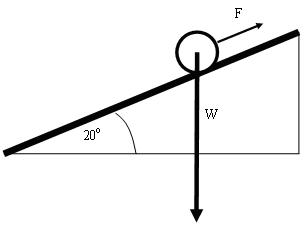 This is a picture of a ball going up a slope at a constant speed.
This is a picture of a ball going up a slope at a constant speed.If it going at constant speed, then
driving force = counter force
Driving force is F, because it is pointing in the direction of motion, by Newton's Second Law which says "Rate of change of momentum is proortional to the resultant force and that change in momentum is in the direction of the resultant force".
However, although gravity is making it harder for the ball to go up the slope, the weight W is NOT the counter force because it is not in line with the motion.
We need to take components of W:
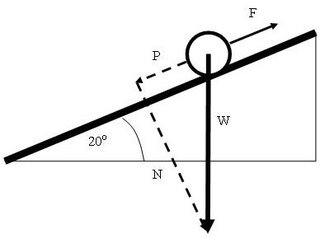 Notice that this has been done using the method set out in my previous post.
Notice that this has been done using the method set out in my previous post.Just in case you were wondering, P stands for parallel to the slope and N stands for normal to the slope.
Lastly we need to look in detail at the components:
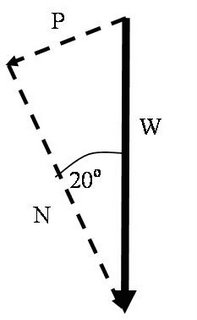
Notice that the bottom angle is the same as the angle for the slope.
By Pythagoras,
P = W sin20
P is the counter force because it is in exactly the opposite direction to the motion (and thus the change in momentum)
Finally, since
Driving force = counter force
F = P
F = W sin20
An example of this type of question might say:
"An object of mass 50 kg travels up a slope of angle 20 degrees at a constant speed of 5 m/s. What is the power output needed to maintain the motion?"
You will of course remember that power output P = Fv. It's on the data sheet.
Hence we already know v, we have to find F
F = W sin 20 but weight W = mg = 50 x 9.81 = 490.5 Newtons
F = 490.5 x sin20 = 167.8 Newtons
Hence power output = Fv = 167.8 Newtons x 5 m/s = 839 Watts to 3 sig fig
One final point: If you have had to put your calculator into RADIANS for maths, make sure you put it back into DEGREES.
past papers
This should be a working link to the past papers section of the AQA website. We are physics syllabus A and we are studying module 2 at the moment:
http://www.aqa.org.uk/qual/gceasa/phya_assess.html
http://www.aqa.org.uk/qual/gceasa/phya_assess.html
Ball on a curved surface

Remember that if you have a force that goes at an angle, you can take components in the horizontal and vertical directions.
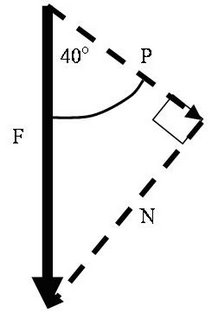 The problem comes when the actual force is either vertical or horizontal in the first place. You might think that there is no point in taking components.
The problem comes when the actual force is either vertical or horizontal in the first place. You might think that there is no point in taking components.However, what if the driving force is the gravitational pull, or weight, and we want the object to move at 40 degrees to the vertical instead of straight down? The answer is that we can come up with components in these directions as long as they make a right angled triangle.
Which brings us to the example below. The ball moves in the direction dictated by the direction of the curve but the only force on it is weight pulling vertically downwards:
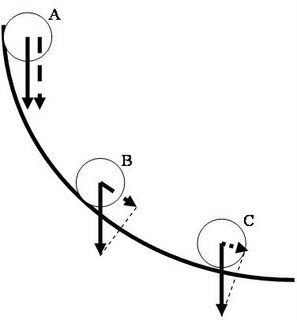
The driving force becomes the component pointing in the direction of the gradient. We do components at A, B and C using the method outlined above.
Notice that in order to keep a right angled triangle, the size of the component becomes progressively smaller. Hence the acceleration decreases in magnitude (size).
In other words, the ball continues to speed up but not by as much each time. It will reach constant speed when the slope becomes horizontal because gravity will no longer be able to make it accelerate.
Thursday, December 14, 2006
Applying Newton's Laws
Remember the very pedantic approach to why a door opens when you kick it.
Your foot hits the door.
The door exerts a force on foot to stop it.
Hence the foot experiences a change in momentum in accodance with Newton's Second Law: The resultant force is proportional to the rate of change of momentum.
However, Newton's Third Law states that: If object A exerts a force on object B, then object B exerts an equal force of the same type on object A in the opposite direction.
Hence there is a reaction force from the foot on the door.
It is this reaction force that then causes a change in momentum forwards on the door to open it, in accordance with Newton's Second Law.
Your foot hits the door.
The door exerts a force on foot to stop it.
Hence the foot experiences a change in momentum in accodance with Newton's Second Law: The resultant force is proportional to the rate of change of momentum.
However, Newton's Third Law states that: If object A exerts a force on object B, then object B exerts an equal force of the same type on object A in the opposite direction.
Hence there is a reaction force from the foot on the door.
It is this reaction force that then causes a change in momentum forwards on the door to open it, in accordance with Newton's Second Law.
Subscribe to:
Comments (Atom)
